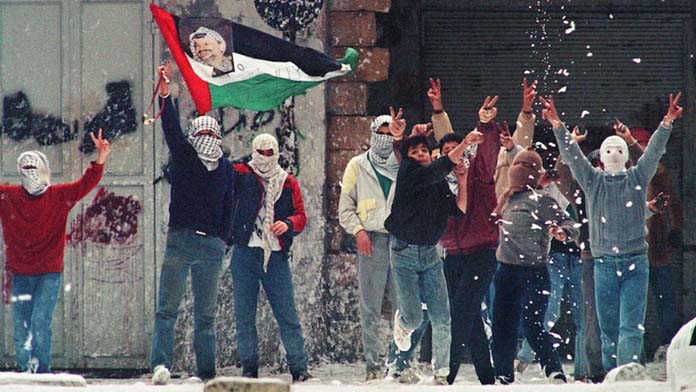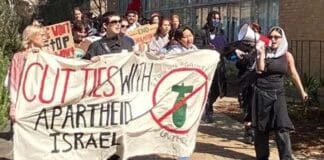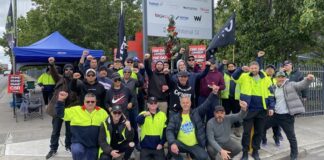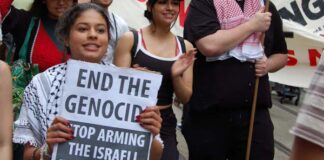The Palestinian Intifada that began in 1987 exposed the brutality of life under occupation and how Palestinians have no choice but to organise resistance, writes Maeve Larkins
The media presents the Hamas 7 October attack as the sole reason for Israel’s genocidal onslaught on Gaza. This erases decades of Israeli occupation and violence against the Palestinians, depicting Palestinian resistance as inexplicable and irrational.
But there is a long history of Palestinian resistance to Israeli colonisation. The mass popular uprising known as the First Intifada is one of its key moments.
By 1987, Palestinians in the West Bank and Gaza had been suffering 20 years of occupation, following Israel’s seizure of the territories in the Six Day War of 1967.
Like now, it was a life of brutal, daily oppression. Palestinians were forcibly removed from their land to make way for Israeli settlements. Israeli troops decided who could leave and enter, patrolling refugee camps and towns.
Any kind of resistance, like waving a Palestinian flag or forming a union would result in prison, beatings, and torture.
The First Intifada exploded from years of frustration with the occupation. The initial spark came on 8 December 1987, when an Israeli truck crushed and killed four Palestinians on the Gaza border. Their funerals in the nearby Jabalia refugee camp in Gaza became mass demonstrations against the occupation.
The Israelis responded brutally, using live ammunition on crowds, killing and injuring further Palestinians. Mass protests spread across Gaza and the West Bank.
Within weeks, activists formed local committees, eventually spanning practically every village, town and camp of the occupied territories. These formed a Unified National Leadership to coordinate the struggle.
This Unified Command organised general strikes and other efforts to disrupt Israel economically. Palestinian workers would refuse to work inside Israel. Palestinian shops would close on specific days and refused to sell any Israeli goods.
Israel responded with an “iron fist” approach. They closed schools and universities and imposed strict curfews. By 1988, Israel was sending 10,000 troops every day into the West Bank and Gaza, using more soldiers than in their conquest in 1967.
They used mass arrests, torture and severe beatings to try to quell the protests.
By the end of 1988, more than 30,000 Palestinians had been detained and hundreds killed. In 1989, Israel outlawed the wearing of a keffiyeh, with a punishment of death.
But the protests did not stop. Over the next five years, Palestinians maintained the uprising in the face of extraordinary repression.
The Unified Command issued appeals for Popular Committees to be formed to coordinate food distribution, produce goods locally, run independent classrooms out of homes and form new trade unions and women’s committees.
One factor in this resilience of the movement was its youth. In Gaza, almost half of the population was younger than 14. This new generation was less traumatised from the defeats of the past and had spent their entire lives under an oppressive Israeli regime.
One such Palestinian was quoted as saying, “Do not feel sorry for us. We are not starving people. We do not want your food. And we are not afraid. No one is afraid of their guns anymore.”
Another factor was its mass involvement.
The Israelis had thought that Palestinian resistance was finished. The First Intifada followed the defeat of Palestinian resistance fighters organised by the Palestine Liberation Organisation (PLO) in Lebanon in 1982.
For decades, the PLO had waged guerilla warfare against Israel from neighbouring states like Jordan and Lebanon, where Palestinians expelled from their homes in 1948 lived crowded into refugee camps.
After Israel invaded Lebanon, the PLO was defeated and driven into exile in Tunisia.
But the First Intifada was a new form of Palestinian resistance—involving those living under Israeli occupation rising up in large numbers.
The movement was overwhelmingly non-violent, with its leadership urging all Palestinian factions to avoid armed actions against Israel.
The IDF, however, had no issue with murdering unarmed protesters. It was Israel’s brutal repression and the feeling that the Intifada had not succeeded that saw the Palestinian resistance resort increasingly to armed struggle after the end of the First Intifada.
The Intifada spreads
Despite the courage and resilience of the movement, the Intifada lacked the power to defeat Israel on its own. After the first year the strikes of Palestinian workers and boycotts of Israeli goods had caused only a 15 per cent reduction in Israeli business activity.
This was enough to rattle Israel’s economy but nowhere near enough to cripple it.
Israel received massive amounts of aid from the US and the West, and ensured the core of its economy relied exclusively on Jewish labour.
Palestinian workers within Israel constituted just 11 per cent of the total labour force and were mostly confined to low paid “dirty jobs” in agriculture and construction.
In response to the strikes during the Intifada, Israel shipped in migrants from Lebanon and Portugal on special working visas.
Similarly, while the IDF was frustrated by its inability to crush the stone-throwing Palestinians, there was no chance of it being routed.
But the impact of the Palestinian uprising did not remain contained to just the West Bank and Gaza.
There is enormous support for the Palestinian cause among the mass of the Arab population.
Just a few weeks after the Intifada began, more than 10,000 protested in solidarity in Lebanon. In Jordan and Bahrain, planned demonstrations were suppressed by the regimes. In Syria, Tunisia, and Kuwait, state-sponsored protests in support of Palestine were quickly overrun by grassroots mobilisations, which were brutally repressed.
Despite Kuwait’s government initially committing $5 million to support the Intifada, it used tear-gas and batons to suppress a pro-Palestinian demonstration of more than 300,000.
In Algeria, the Intifada provoked strikes across its largest factories demanding better wages. The strikes spilled into street riots demanding an end to soaring prices brought on by the regime’s privatisations.
Youths fought police with stones, some wearing keffiyehs as a show of unity with the Palestinians.
Support for the Palestinians threatened to spill over into revolts against the surrounding Arab regimes, destabilising the whole Middle East.
For the Arab masses, the Intifada was an inspiration not only as a movement of resistance to Israel, but also in the fight against the inequality, poverty and brutality of life under their own oppressive regimes.
The rulers of Egypt, Jordan and the Gulf States had carved a place for themselves in the system of global capitalism and imperialism, making their peace with Israel and the US. And regimes like Iran and Syria, while antagonists of the US, aspired to boost their own power in similar ways.
Peace talks
This impact across the region explains why the US began to push for a settlement between Israel and the Palestinians.
The US reached out to Yasser Arafat, the head of the PLO, and offered to facilitate peace talks, on the condition that the PLO revoked its commitment to armed struggle and recognised Israel as a legitimate state.
Arafat conceded. Previously, the PLO had maintained a commitment to liberating the whole of historic Palestine and instituting a single democratic state with equal rights for Jews and Arabs.
Now the PLO backflipped, aiming simply to establish a state within the occupied territories of the West Bank, Gaza and East Jerusalem. This meant abandoning the possibility of Palestinians returning to the lands they were brutally expelled from in 1948 when Israel was created.
The PLO’s capitulation was a product of desperation, following its defeat and exile in Tunisia.
Its strategy of armed struggle had always involved looking to the Arab rulers for support in achieving a Palestinian state.
However, maintaining this support meant the PLO turning its back on resistance within the Arab states from workers and the poor—the key force capable of challenging Israel and Western imperialism.
The PLO had long held a “non-interference policy”, forbidding any involvement in the internal politics of the Arab states. During the Intifada, the PLO instructed its members not to join or issue any leaflets or statements that supported the protests against the regimes in Jordan and Kuwait.
They feared doing so would jeopardise the possibility of international legal recognition. Just three months after Intifada began, PLO leader Bassam Abu-Sharif argued, “The US must be made to feel that it is in her interests that an independent Palestinian state be created … A Palestinian state in the Middle East will be the safety valve in the region.”
The result of the First Intifada was a peace process that would culminate in the Oslo Accords in 1993. But a Palestinian state was never delivered.
Instead the PLO was effectively integrated into the Israeli occupation. It was given control of the Palestinian Authority as a police force to suppress Palestinian resistance in the face of the encroachment of Israeli settlements.
Palestinian academic Edward Said rightly called the Oslo Accords, “An instrument of Palestinian surrender.”
Since 1989, Israeli settlements in the West Bank have more than doubled in size. Border checkpoints and Israeli security forces there have massively expanded.
Frustration with the dead-end of the Oslo Accords would later boil over into a Second Intifada in 2000.
Palestinian liberation and an end to Israel’s occupation can come only through a revolt across the region that topples US-backed regimes like Jordan, Egypt and the Gulf States.
The only force with the power to achieve this is the working class of the region. The real hope for Palestinian liberation lies in building a socialist movement committed to a revolution to smash imperialism and the capitalist system behind it.






